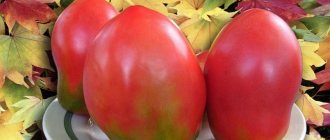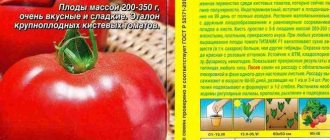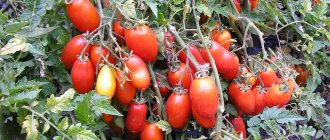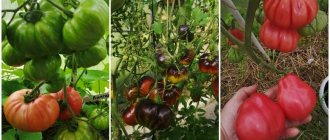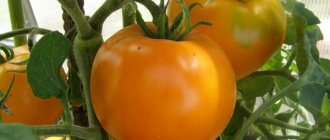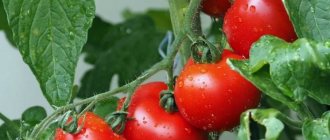For many people, it is now interesting to grow unusual tomatoes that will delight not only with their taste, but also with their appearance. I will be happy to share my secrets with you and tell you about the best unusual varieties of tomatoes.
I have been gardening for over 20 years, just like my mother and grandmother before that. For as long as I can remember, we have been growing tomatoes in our dacha. They were the most common round red ones, although sometimes you could buy so-called ladyfingers. It was great luck! We usually hid them green, stored them in boxes, carefully covered them with newspaper, and put red apples next to them so that the tomatoes would ripen faster. I can’t say that they were tasty, but they were their own! Then in vegetable stores there was nothing except potatoes in paper bags, beets, onions, carrots and cabbage. Sometimes they “threw away” bananas, Moroccan tangerines or oranges. Then gigantic queues lined up behind them, like at the Mausoleum. And I had to go to the market to buy tomatoes. They were brought from warm fraternal republics.
My garden
But time passes, progress does not stand still, the borders are open, many agricultural firms have appeared, and with them competition, and an avalanche of various varieties and hybrids of tomatoes has fallen on poor gardeners. Our agricultural companies began vying with each other to offer tomatoes of all shapes and colors, and collectors also arrived, offering tomatoes of incredible beauty and taste. There are so many varieties here: from white to black, bicolors, tricolors, striped, with highlights, speckled, intricate shapes and sizes, from cherry to giant. Tomatoes for snacking, salad varieties, for whole-fruit canning, for sauces, juice, adjika and pastes! And what names: Velvet Katya in Yellow, Amethyst Jewel, Wild Thyme, Wild Beauty, Plan 9 from Outer Space, Join or Die, The Risen Starfighter, Brad's Atomic Grapes. Poetry, not names! And what a variety of tastes, from the usual rich tomato to bright fruit!
So, it's all about the choice of seeds
My recommendations for tomato varieties
Plans for the winter
General description of the variety
“Lucid Jam” is a beautiful mid-early variety from the 2022-2016 collection. In many collectors' catalogs this variety is called "Bright Gem". It begins to bear fruit 110-115 days from the moment the sprouts germinate. Plants of indeterminate type, but with moderate growth vigor. In a greenhouse, the average height of the bushes reaches 1.6-1.7 m, in open ground 1.4-1.5 m. The bush is strong with a powerful main stem, branched, with foliage of the ordinary type, light green in color.
Suitable for cultivation throughout the country. Tomatoes of this variety are not afraid of either temporary drops in temperature or excessive heat. In the middle zone, under greenhouse conditions, it will bear fruit until frost; in the southern regions it grows well in open beds. Ardent fans of the variety reap an excellent harvest even without shelter in different areas from the Moscow region to the Urals.
The fruits of this variety fill on average up to 200-250 g. Tomatoes of extraordinary beauty turn yellow at the beginning of ripening, then acquire a bright orange color with beautiful blue-violet splashes and stripes. Pigmentation is most intense on the side facing the sun and intensifies as the fruit ripens. The pulp is characteristic of bi-color tomatoes: yellow-orange in cross section with a bright red center. The taste is sweet with fruity notes, very juicy, fleshy, aromatic, with an almost complete absence of seeds. The beautiful fruits have the ability to hang on the bush for a long time and their taste is fully revealed.
Tomatoes acquire their unusual color due to the presence of anthocyanin pigment.
In addition to their visual appeal, blue-violet tomatoes have the following advantages:
- have an exotic but balanced taste;
- remove toxins from the body;
- strengthen the cardiovascular system;
- reduce the risk of cancer;
- improve vision.
Unusually healthy tomatoes are most often consumed in their natural form or used to prepare summer salads. But they are also great for making various winter supplies: lecho, sauces, juices, borscht dressings.
The fruits tolerate transportation well and are stored well for up to one month.
These two properties make it possible to grow tomatoes for sale. The demand for exotic tomatoes is very good, despite the fairly high price. Interesting! There is an opinion that all blue-violet tomatoes are obtained exclusively with the help of genetically modified organisms. Of course, these exist, but not all of them, and the “Lucid Jam” variety is not one of them. It is easy to distinguish GMO tomatoes from traditionally bred ones. In genetically modified fruits, anthocyanin is contained in all cells, so when cut, they are also blue-violet like the skin. In tomatoes obtained in the usual way, only the skin has an exotic color, and the flesh can be from yellow to red, but without a blue tint.
In fact, the selection of blue tomatoes began in Bulgaria back in the 60s. It was then that the first tomatoes similar in color to eggplants appeared. In those days, this new selection was not particularly successful. And only in our time, scientists have discovered all the benefits of the anthocyanin pigment and tomatoes have gained well-deserved popularity and distribution.
Orange strawberry (Orange berry)
A mid-season indeterminate variety of tomatoes that can be grown both in open ground and in a greenhouse. The plant is tall: in open beds it reaches a height of 1.7-2 m, in protected ground - 3.5 m. Manufacturers recommend forming a bush with 2-3 stems. Gartering and pinching are required. Productivity is about 6 kg per bush.
Large-fruited variety. Each cluster produces 4-6 fruits. The first tomatoes ripen 100-110 days after emergence. The average weight of a tomato is 400-500 g. The fruits are orange, heart-shaped. The pulp is dense, fleshy. The taste is sweet with a slight sourness. Tomatoes are intended for fresh consumption, as well as for making ketchup and tomato paste.
Features of cultivation
Timing of sowing seeds
The exact time of sowing seeds is determined by the climatic conditions of a particular region. Seeds of mid-season tomatoes, which include “Lucid Jam,” are recommended to be sown two months before planting in the ground. If you neglect this recommendation and plant the seeds earlier, the results will be disappointing. Overgrown seedlings do not take root well and often shed a large amount of color and ovaries.
Approximate timing of sowing seeds for planting in the ground without shelter:
- Moscow region: from March 15 to the first days of April.
- Siberia: first ten days of April.
- Ural: second ten days of April.
- Krasnodar region: first ten days of March.
To determine the sowing time for transplanting into protected soil conditions, you need to focus on the microclimate in a particular greenhouse.
Transplantation to a permanent place
By the time the tomatoes are transplanted, the soil should have warmed up well and the spring frosts should have passed irrevocably. Seedlings should be strong, have 8-9 true leaves and one raceme of color.
The technique for planting tomato seedlings in open ground is the same as in a greenhouse: holes are made in the beds at a distance of 50-70 cm, depending on the planned number of stems, and 70-80 cm between rows. The designated holes are poured with plenty of water and plants with a native clod of earth are planted in the resulting “mud”. The holes are filled with soil and carefully compacted. After this, the bed is covered with a mulch layer.
After transplanting, the tomatoes are left alone for 10-14 days so that the plants get accustomed to the new conditions and become stronger. It is only necessary to keep the soil moist. In open ground, in the scorching sun, you can shade young bushes using newspaper caps or a special mesh.
Plant nutrition
Large-fruited and tall tomatoes like Lucid Jam require increased amounts of nutrients. Therefore, they usually carry out 3-4 feedings over the entire season.
Approximate diagram:
- 20 days after transplantation. Ingredients: 20 gr. nitrophoska (1/2 matchbox) and 0.5 liters of liquid mullein are diluted in 10 liters of water. Consumption per plant is one liter of solution.
- 10-14 days after the first feeding. Ingredients: 20 gr. granulated superphosphate (1 matchbox) and one teaspoon of potassium sulfate are dissolved in 10 liters of water. Consumption: 5 liters per square meter.
- Two weeks after the second feeding. One liter of any manure is carefully diluted in a bucket of water (10-15 liters). Consumption: 7-8 liters per square meter.
- During the period of fruit formation. Ingredients: 2 teaspoons of sodium humate and 1 matchbox of granulated superphosphate are diluted in 10 liters of water. Consumption: 5 liters per square meter.
Information! During active flowering, plants are additionally sprayed with boric acid. To do this, one teaspoon of the product is diluted in 10 liters of water.
Shaping and tying
Tall Lucid Jam tomato bushes are prone to growing a large number of shoots and therefore need to be shaped and tied up throughout the entire growing season.
Plants can be formed into one, two or three stems. When forming a bush into one stem, all side shoots growing from the axils of the leaves are removed and only 6-7 fruit clusters are retained. The crown is pinched, leaving 3-4 leaves above the top flower cluster.
When two stems are formed, in addition to the main shoot, a stepson is left for growth, which will grow under the first peduncle. In this case, 4 clusters with fruits are kept on the main trunk and the crown is pinched in the same way as with the first method. 3 fruit clusters are left on the stepson and the crown is also pinched.
When three stems are formed, 2-3 clusters with fruits are left on each of them and the pinching procedure is carried out.
Proper management of tomato plants ensures that all the beneficial substances go not to the growth of the green mass of the plants, but to the formation and filling of fruits. Accordingly, their size increases, and maturation occurs much earlier.
Cardinal
A mid-season indeterminate variety of tomatoes, which are recommended to be grown in protected soil in the middle zone. The height of the bush in the greenhouse reaches 2 m, so the plant needs support and garter. When forming, you should not leave more than 1-2 stems, otherwise the yield will decrease. On average, 4-5 kg of tomatoes are harvested from each bush.
Fruiting begins 110-115 days after emergence. The fruits are heart-shaped, slightly ribbed, round. The weight of the first tomatoes reaches 900 g. Later they become smaller and at the end of the fruiting period they grow to 300-400 g. The color of the fruit is pink-crimson. The pulp is sweet, sugary. Tomatoes are used both for fresh consumption and for making sauces and juices.
Diseases and pests
The Lucid Jam tomato variety is resistant to major nightshade diseases. But in unfavorable weather, late blight can affect even the most resistant plants. Therefore, prevention with folk remedies will not be superfluous. The simplest and safest way to prevent fungal diseases, according to experienced gardeners, is sour milk or kefir, diluted in half with water. Some vegetable growers add a few drops of iodine to this solution. Such treatments are carried out every 10-15 days starting in July.
The most dangerous pest for tomatoes is the mole cricket. If it gets into a defenseless tomato bed, it can instantly eat up all the bushes. If the area is characterized by this pest, it is necessary to set traps with bait. To do this, dark, unfiltered beer is poured into bottles and buried in the ground at an angle. In this case, it is important that the neck of the bottles remains above the ground and is freely accessible. Mole crickets are great at falling into such “beer” traps, but they can’t get back out.
Advantages and disadvantages of the variety
The undoubted advantages of this variety include:
- good yield;
- fairly fast ripening period;
- tasty and healthy fruits;
- unusual and beautiful color of tomatoes;
- strong and stable bush;
- forms ovaries well despite cold or heat;
- good keeping quality and transportability of fruits;
- resistance to diseases.
The variety can be called ideal; it has no flaws. The peculiarities of growing include the need to tie the bushes to a support and shape the plants.
Many people believe that only vegetable growers with extensive experience can grow collection tomatoes. In fact, planting and caring for them is no different from cultivating ordinary varieties of tomatoes and is feasible even for novice summer residents.
My recommendations for tomato varieties
I’m telling you how not to lose your head from the abundance of seeds, and I myself bought so many that it’s time to open a seed store myself! This year I planted about 60 varieties and hybrids of tomatoes from different companies and collectors. The selection was very tough, I wanted everything at once, but I understood that I had limited space on the site. The emphasis was on collectible tomatoes, which were of unusual colors and, judging by the description, fabulously tasty.
This year it was a pleasant discovery for me tomatoes: Firewood, Gigolo, Hungarian Kecskemeti, Solerosso, Avyuri orange, Geranium Kiss, Jack Pot, Violet Emerald. And I’ve been planting Golden Lemon and Michael Pollan for the second year. Of course, Cherry Paints and Cherry Your Nobility look beautiful in jars. Each tomato not only has its own taste, but also color and shape. When I was approaching planting the 50th variety of multi-colored tomatoes, I realized that I had not planted ordinary, red tomatoes for preparations at all, and the collection ones were not something to make into sauces, it was a pity to eat them. They are so beautiful!
